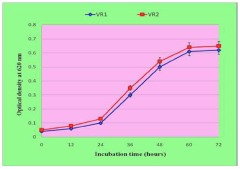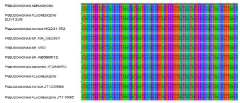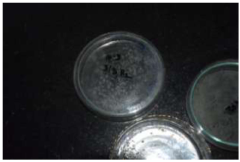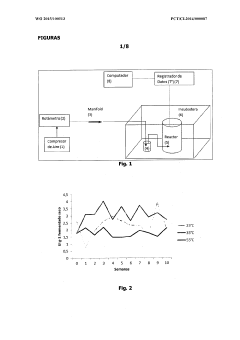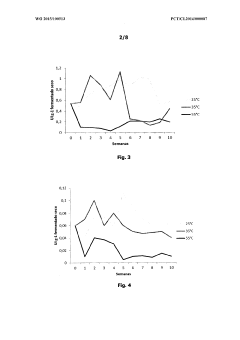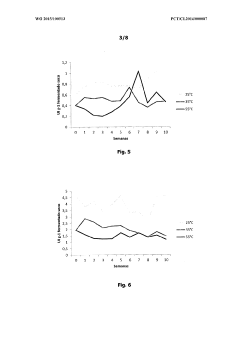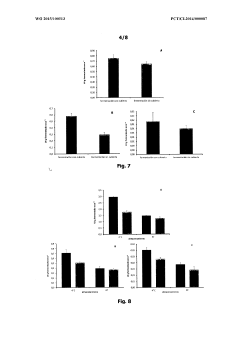Biofertilizers: Empowering Agricultural Tech for Resource Efficiency
JUL 15, 20259 MIN READ
Generate Your Research Report Instantly with AI Agent
Patsnap Eureka helps you evaluate technical feasibility & market potential.
Biofertilizer Evolution
The evolution of biofertilizers represents a significant paradigm shift in agricultural practices, moving from traditional chemical-based fertilizers to more sustainable and environmentally friendly alternatives. This journey began in the early 20th century with the discovery of nitrogen-fixing bacteria, but it wasn't until the 1970s that biofertilizers gained serious attention as a potential solution to the environmental concerns associated with chemical fertilizers.
The first generation of biofertilizers primarily focused on nitrogen fixation, with products based on Rhizobium bacteria for leguminous crops. These early biofertilizers demonstrated the potential for reducing chemical nitrogen inputs while maintaining crop yields. As research progressed, the scope of biofertilizers expanded to include phosphate solubilizing bacteria and mycorrhizal fungi, addressing a broader range of plant nutritional needs.
The 1990s saw a surge in biofertilizer research and development, driven by growing environmental awareness and the need for sustainable agriculture. This period marked the emergence of multi-strain biofertilizers, combining different beneficial microorganisms to provide a more comprehensive nutrient profile. Concurrently, advances in biotechnology enabled the development of more efficient microbial strains and improved formulation techniques, enhancing the stability and efficacy of biofertilizer products.
The turn of the millennium brought about a new era in biofertilizer evolution, characterized by the integration of nanotechnology and genetic engineering. Nanoformulations improved the delivery and bioavailability of microbial inoculants, while genetic modifications enhanced the performance of beneficial microorganisms under various environmental conditions. This period also saw the development of biofertilizers tailored for specific crops and soil types, marking a shift towards precision agriculture.
In recent years, the focus has shifted towards developing "smart" biofertilizers that not only provide nutrients but also enhance plant resilience to abiotic stresses such as drought and salinity. The advent of high-throughput sequencing and bioinformatics has revolutionized the discovery and characterization of novel microbial strains, leading to more diverse and effective biofertilizer formulations.
The latest frontier in biofertilizer evolution involves the integration of artificial intelligence and machine learning to optimize microbial consortia and predict their performance under various environmental conditions. This approach, coupled with advances in microbiome research, is paving the way for next-generation biofertilizers that can dynamically adapt to changing soil conditions and plant needs.
As we look to the future, the evolution of biofertilizers is likely to continue along the path of increased sophistication and customization. The integration of biofertilizers with other sustainable agricultural practices, such as precision farming and conservation tillage, promises to further enhance resource efficiency and crop productivity while minimizing environmental impact.
The first generation of biofertilizers primarily focused on nitrogen fixation, with products based on Rhizobium bacteria for leguminous crops. These early biofertilizers demonstrated the potential for reducing chemical nitrogen inputs while maintaining crop yields. As research progressed, the scope of biofertilizers expanded to include phosphate solubilizing bacteria and mycorrhizal fungi, addressing a broader range of plant nutritional needs.
The 1990s saw a surge in biofertilizer research and development, driven by growing environmental awareness and the need for sustainable agriculture. This period marked the emergence of multi-strain biofertilizers, combining different beneficial microorganisms to provide a more comprehensive nutrient profile. Concurrently, advances in biotechnology enabled the development of more efficient microbial strains and improved formulation techniques, enhancing the stability and efficacy of biofertilizer products.
The turn of the millennium brought about a new era in biofertilizer evolution, characterized by the integration of nanotechnology and genetic engineering. Nanoformulations improved the delivery and bioavailability of microbial inoculants, while genetic modifications enhanced the performance of beneficial microorganisms under various environmental conditions. This period also saw the development of biofertilizers tailored for specific crops and soil types, marking a shift towards precision agriculture.
In recent years, the focus has shifted towards developing "smart" biofertilizers that not only provide nutrients but also enhance plant resilience to abiotic stresses such as drought and salinity. The advent of high-throughput sequencing and bioinformatics has revolutionized the discovery and characterization of novel microbial strains, leading to more diverse and effective biofertilizer formulations.
The latest frontier in biofertilizer evolution involves the integration of artificial intelligence and machine learning to optimize microbial consortia and predict their performance under various environmental conditions. This approach, coupled with advances in microbiome research, is paving the way for next-generation biofertilizers that can dynamically adapt to changing soil conditions and plant needs.
As we look to the future, the evolution of biofertilizers is likely to continue along the path of increased sophistication and customization. The integration of biofertilizers with other sustainable agricultural practices, such as precision farming and conservation tillage, promises to further enhance resource efficiency and crop productivity while minimizing environmental impact.
Sustainable Agri Demand
The global agricultural sector is experiencing a significant shift towards sustainable practices, driven by increasing environmental concerns and the need for resource efficiency. This trend has led to a growing demand for biofertilizers, which are environmentally friendly alternatives to conventional chemical fertilizers. The market for biofertilizers is expanding rapidly, with projections indicating substantial growth in the coming years.
Farmers worldwide are recognizing the benefits of biofertilizers in improving soil health, enhancing crop yields, and reducing environmental impact. These products offer a sustainable solution to the challenges posed by intensive farming practices, such as soil degradation and nutrient depletion. As a result, there is a rising interest in biofertilizer research and development, aimed at creating more effective and versatile products.
The demand for biofertilizers is particularly strong in regions facing soil fertility issues and environmental regulations limiting the use of chemical fertilizers. Developing countries, where small-scale farming is prevalent, are showing increased adoption of biofertilizers due to their cost-effectiveness and suitability for organic farming practices. This trend is supported by government initiatives promoting sustainable agriculture and organic food production.
In developed nations, the push for sustainable agriculture is driven by consumer preferences for organic products and stricter environmental regulations. Large-scale commercial farms are increasingly incorporating biofertilizers into their crop management strategies to meet these demands while maintaining productivity. This shift is creating new market opportunities for biofertilizer manufacturers and stimulating innovation in product formulations.
The biofertilizer industry is responding to this demand by diversifying product offerings and improving formulation technologies. Research is focused on developing biofertilizers that are more stable, have a longer shelf life, and are effective across a wider range of crops and soil conditions. There is also growing interest in customized biofertilizer solutions that address specific regional soil deficiencies and crop requirements.
The integration of biofertilizers with precision agriculture technologies is another emerging trend. This combination allows for more targeted and efficient application of biofertilizers, further enhancing their appeal to modern farmers seeking to optimize resource use. As a result, the biofertilizer market is not only expanding but also evolving to meet the complex needs of sustainable agriculture in the 21st century.
Farmers worldwide are recognizing the benefits of biofertilizers in improving soil health, enhancing crop yields, and reducing environmental impact. These products offer a sustainable solution to the challenges posed by intensive farming practices, such as soil degradation and nutrient depletion. As a result, there is a rising interest in biofertilizer research and development, aimed at creating more effective and versatile products.
The demand for biofertilizers is particularly strong in regions facing soil fertility issues and environmental regulations limiting the use of chemical fertilizers. Developing countries, where small-scale farming is prevalent, are showing increased adoption of biofertilizers due to their cost-effectiveness and suitability for organic farming practices. This trend is supported by government initiatives promoting sustainable agriculture and organic food production.
In developed nations, the push for sustainable agriculture is driven by consumer preferences for organic products and stricter environmental regulations. Large-scale commercial farms are increasingly incorporating biofertilizers into their crop management strategies to meet these demands while maintaining productivity. This shift is creating new market opportunities for biofertilizer manufacturers and stimulating innovation in product formulations.
The biofertilizer industry is responding to this demand by diversifying product offerings and improving formulation technologies. Research is focused on developing biofertilizers that are more stable, have a longer shelf life, and are effective across a wider range of crops and soil conditions. There is also growing interest in customized biofertilizer solutions that address specific regional soil deficiencies and crop requirements.
The integration of biofertilizers with precision agriculture technologies is another emerging trend. This combination allows for more targeted and efficient application of biofertilizers, further enhancing their appeal to modern farmers seeking to optimize resource use. As a result, the biofertilizer market is not only expanding but also evolving to meet the complex needs of sustainable agriculture in the 21st century.
Biofertilizer Challenges
Despite the promising potential of biofertilizers in sustainable agriculture, several challenges hinder their widespread adoption and efficacy. One of the primary obstacles is the inconsistent performance of biofertilizers across different environmental conditions. Soil characteristics, climate variations, and existing microbial communities can significantly impact the effectiveness of introduced beneficial microorganisms, leading to unpredictable results in diverse agricultural settings.
Another major challenge is the limited shelf life of many biofertilizer products. The viability of living microorganisms in these formulations tends to decrease over time, reducing their efficacy and making long-term storage and distribution problematic. This issue is particularly acute in regions with inadequate cold storage facilities or extended transportation times.
The lack of standardized quality control measures and regulations for biofertilizer production and application poses a significant hurdle. Without proper guidelines, the market is flooded with substandard products, eroding farmer trust and impeding the adoption of genuinely effective biofertilizers. This challenge is compounded by the difficulty in maintaining consistent product quality due to the inherent variability of living microorganisms.
Compatibility issues between biofertilizers and conventional agricultural practices present another obstacle. Many farmers are accustomed to using chemical fertilizers and pesticides, which can be detrimental to the beneficial microorganisms in biofertilizers. Integrating biofertilizers into existing farming systems often requires a shift in management practices, which can be met with resistance from farmers.
The slow-acting nature of biofertilizers compared to chemical fertilizers is a significant drawback for many farmers. While biofertilizers offer long-term soil health benefits, their immediate effects on crop yield may be less pronounced, making it challenging to convince farmers of their value, especially in regions where short-term productivity is prioritized.
Technical challenges in formulation and application methods also persist. Developing carrier materials that can support microbial survival while allowing easy application remains an ongoing research focus. Additionally, ensuring the efficient delivery of beneficial microorganisms to the plant rhizosphere and their subsequent colonization is crucial for biofertilizer effectiveness.
Lastly, the limited understanding of complex plant-microbe interactions and the mechanisms by which biofertilizers enhance nutrient uptake and plant growth hampers the development of more targeted and efficient products. Overcoming these scientific knowledge gaps is essential for advancing biofertilizer technology and improving its reliability and performance across diverse agricultural ecosystems.
Another major challenge is the limited shelf life of many biofertilizer products. The viability of living microorganisms in these formulations tends to decrease over time, reducing their efficacy and making long-term storage and distribution problematic. This issue is particularly acute in regions with inadequate cold storage facilities or extended transportation times.
The lack of standardized quality control measures and regulations for biofertilizer production and application poses a significant hurdle. Without proper guidelines, the market is flooded with substandard products, eroding farmer trust and impeding the adoption of genuinely effective biofertilizers. This challenge is compounded by the difficulty in maintaining consistent product quality due to the inherent variability of living microorganisms.
Compatibility issues between biofertilizers and conventional agricultural practices present another obstacle. Many farmers are accustomed to using chemical fertilizers and pesticides, which can be detrimental to the beneficial microorganisms in biofertilizers. Integrating biofertilizers into existing farming systems often requires a shift in management practices, which can be met with resistance from farmers.
The slow-acting nature of biofertilizers compared to chemical fertilizers is a significant drawback for many farmers. While biofertilizers offer long-term soil health benefits, their immediate effects on crop yield may be less pronounced, making it challenging to convince farmers of their value, especially in regions where short-term productivity is prioritized.
Technical challenges in formulation and application methods also persist. Developing carrier materials that can support microbial survival while allowing easy application remains an ongoing research focus. Additionally, ensuring the efficient delivery of beneficial microorganisms to the plant rhizosphere and their subsequent colonization is crucial for biofertilizer effectiveness.
Lastly, the limited understanding of complex plant-microbe interactions and the mechanisms by which biofertilizers enhance nutrient uptake and plant growth hampers the development of more targeted and efficient products. Overcoming these scientific knowledge gaps is essential for advancing biofertilizer technology and improving its reliability and performance across diverse agricultural ecosystems.
Current Biofertilizers
01 Microbial biofertilizers for improved resource efficiency
Microbial biofertilizers enhance nutrient uptake and utilization in plants, improving resource efficiency in agriculture. These biofertilizers contain beneficial microorganisms that colonize the rhizosphere, promoting plant growth and reducing the need for chemical fertilizers. This approach leads to more sustainable farming practices and increased crop yields while minimizing environmental impact.- Microbial biofertilizers for improved resource efficiency: Microbial biofertilizers enhance nutrient uptake and utilization in plants, improving resource efficiency in agriculture. These formulations contain beneficial microorganisms that can fix nitrogen, solubilize phosphorus, or produce plant growth-promoting substances, reducing the need for chemical fertilizers and optimizing nutrient use.
- Smart application systems for biofertilizers: Advanced application systems for biofertilizers utilize precision agriculture techniques and IoT devices to optimize the timing and dosage of biofertilizer applications. These systems can monitor soil conditions, plant health, and environmental factors to ensure efficient use of biofertilizers and maximize their effectiveness.
- Nanotechnology-enhanced biofertilizers: Incorporating nanotechnology in biofertilizer formulations can improve their efficiency and effectiveness. Nanoparticles can enhance the delivery and absorption of nutrients, increase the stability of beneficial microorganisms, and provide controlled release of active ingredients, leading to more efficient resource utilization.
- Biofertilizers from waste materials: Developing biofertilizers from organic waste materials, such as agricultural residues or food industry by-products, promotes resource efficiency by recycling nutrients and reducing waste. These biofertilizers can improve soil health, increase crop yields, and contribute to a circular economy in agriculture.
- Integration of biofertilizers with precision farming: Combining biofertilizer applications with precision farming techniques, such as variable rate technology and remote sensing, can optimize resource use efficiency. This approach allows for targeted application of biofertilizers based on specific crop needs and soil conditions, minimizing waste and maximizing the benefits of these biological inputs.
02 Smart application systems for biofertilizers
Advanced application systems for biofertilizers optimize resource use by precisely delivering the right amount of biofertilizers to crops. These systems may incorporate sensors, IoT devices, and AI algorithms to monitor soil conditions and plant needs, ensuring efficient distribution of biofertilizers. This technology reduces waste and improves the overall effectiveness of biofertilizer applications.Expand Specific Solutions03 Nanotechnology-enhanced biofertilizers
Nanotechnology is being utilized to develop more efficient biofertilizers. Nanoparticles can act as carriers for beneficial microorganisms or nutrients, improving their delivery and absorption by plants. This approach enhances the efficacy of biofertilizers, leading to better resource utilization and reduced environmental impact compared to conventional fertilizers.Expand Specific Solutions04 Biofertilizer formulations for stress tolerance
Specialized biofertilizer formulations are being developed to enhance plant tolerance to various environmental stresses such as drought, salinity, and extreme temperatures. These formulations contain specific microorganisms or compounds that help plants better utilize available resources under challenging conditions, thereby improving overall resource efficiency in agriculture.Expand Specific Solutions05 Integration of biofertilizers with precision agriculture
The integration of biofertilizers with precision agriculture techniques optimizes resource use in farming. This approach combines biofertilizer applications with data-driven decision-making, using technologies such as GPS, remote sensing, and machine learning. By tailoring biofertilizer use to specific crop and soil needs, farmers can maximize efficiency and minimize waste.Expand Specific Solutions
Agri-biotech Leaders
The biofertilizer market is in a growth phase, driven by increasing demand for sustainable agricultural practices and environmental concerns. The global market size is projected to expand significantly in the coming years, with a compound annual growth rate of over 10%. Technological maturity varies across different types of biofertilizers, with some well-established products and others still in development. Key players like Valagro SpA, Nanjing Agricultural University, and Shenyang Agricultural University are leading research and innovation efforts. Companies such as Zhongcang Eco-Agriculture Co., Ltd. and Hebei New Century Zhoutian Biotechnology Co., Ltd. are focusing on commercialization and market expansion. The industry is characterized by a mix of established agricultural firms and innovative startups, indicating a dynamic and competitive landscape.
Zhongcang Eco-Agriculture Co., Ltd
Technical Solution: Zhongcang Eco-Agriculture Co., Ltd has developed a range of biofertilizers based on traditional Chinese agricultural practices combined with modern biotechnology. Their products focus on improving soil microbial diversity and enhancing nutrient cycling in agricultural ecosystems. The company has patented several microbial consortia specifically designed for major crops in China, including rice, wheat, and vegetables[9]. Zhongcang's research emphasizes the use of endophytic bacteria and fungi that can colonize plant tissues, providing long-term benefits throughout the growing season. They have also developed innovative application methods, such as seed coating technologies, to improve the delivery and efficacy of their biofertilizer products[10].
Strengths: Strong integration of traditional knowledge with modern science. Extensive field testing network across diverse agricultural regions in China. Weaknesses: Limited international presence may restrict global market access. Potential challenges in adapting products to significantly different agricultural systems outside China.
Nanjing Agricultural University
Technical Solution: Nanjing Agricultural University has developed innovative biofertilizer formulations using plant growth-promoting rhizobacteria (PGPR) and arbuscular mycorrhizal fungi (AMF). Their research focuses on enhancing nutrient uptake efficiency and stress tolerance in crops. They have successfully isolated and characterized novel strains of Bacillus and Pseudomonas with multiple plant growth-promoting traits[1]. The university has also pioneered the use of nanotechnology in biofertilizer delivery systems, creating slow-release formulations that improve the longevity and effectiveness of microbial inoculants in the soil[3]. Their approach combines traditional microbiology with cutting-edge biotechnology to develop sustainable agricultural solutions.
Strengths: Strong research foundation in microbial ecology and plant-microbe interactions. Advanced facilities for microbial isolation and characterization. Weaknesses: Limited field-scale validation of laboratory findings. Potential challenges in scaling up production for commercial use.
Key Microbial Strains
Biofertilizer formulation comprising organic matter and pseudomonas fluorescens (PGPR)
PatentPendingIN202211015762A
Innovation
- A biofertilizer formulation comprising Pseudomonas fluorescens (PGPR) and an organic matter solution characterized by Cow urine or dried cow dung, Neem leaves extract, Green Chili extract, Garlic extract, Tobacco, Datura stramonium leaves extract, and Calotropis gigantea (Aak) leaves extract, which is applied in both liquid and solid forms to enhance crop yield, soil quality, and microbial activity.
Method of producing a biofertilizer comprising fermentation in the solid state, immobilization by means of allophane nanoparticles and renewed fermentation, and biofertilizer
PatentWO2015100513A1
Innovation
- A biofertilizer process involving solid-state fermentation, enzyme immobilization using allophan nanoparticles, and a second fermentation stage to produce and encapsulate enzymes like phosphatases, sulfastases, and glutaminases, which are then combined with organic substrates and beneficial microorganisms to create a controlled release of nutrients matching plant needs.
Regulatory Framework
The regulatory framework surrounding biofertilizers plays a crucial role in shaping their development, production, and application in agriculture. As these innovative products gain traction in the global market, governments and international organizations are working to establish comprehensive guidelines and standards to ensure their safety, efficacy, and environmental sustainability.
At the national level, many countries have implemented specific regulations for biofertilizers. These regulations typically cover aspects such as product registration, quality control, labeling requirements, and application protocols. For instance, in India, the Fertilizer Control Order (FCO) has been amended to include biofertilizers, setting standards for their production and distribution.
The European Union has established a regulatory framework for biofertilizers under the EU Fertilizing Products Regulation (EU) 2019/1009. This regulation aims to harmonize the rules for biofertilizers across member states, facilitating their free movement within the EU market while ensuring high standards of quality and safety.
In the United States, the Environmental Protection Agency (EPA) regulates biofertilizers under the Federal Insecticide, Fungicide, and Rodenticide Act (FIFRA). The EPA requires manufacturers to register their products and provide data on their composition, efficacy, and potential environmental impacts.
International organizations, such as the Food and Agriculture Organization (FAO) of the United Nations, have also developed guidelines for the production and use of biofertilizers. These guidelines aim to promote best practices and standardization across different countries, particularly in developing regions where regulatory frameworks may be less established.
One of the key challenges in regulating biofertilizers is the need to balance innovation and safety. Regulators must ensure that the approval process does not stifle the development of new, potentially beneficial products while still maintaining rigorous standards to protect human health and the environment.
As research on biofertilizers continues to advance, regulatory frameworks are likely to evolve. Future regulations may focus on specific types of biofertilizers, such as those containing genetically modified organisms or novel microbial strains. Additionally, there is a growing emphasis on developing standardized testing methods to assess the efficacy and environmental impact of biofertilizers, which will inform future regulatory decisions.
The harmonization of international standards for biofertilizers remains an ongoing challenge. As the global trade in these products increases, there is a need for greater cooperation between regulatory bodies to ensure consistent quality and safety standards across borders. This may lead to the development of international certification schemes or mutual recognition agreements between countries.
At the national level, many countries have implemented specific regulations for biofertilizers. These regulations typically cover aspects such as product registration, quality control, labeling requirements, and application protocols. For instance, in India, the Fertilizer Control Order (FCO) has been amended to include biofertilizers, setting standards for their production and distribution.
The European Union has established a regulatory framework for biofertilizers under the EU Fertilizing Products Regulation (EU) 2019/1009. This regulation aims to harmonize the rules for biofertilizers across member states, facilitating their free movement within the EU market while ensuring high standards of quality and safety.
In the United States, the Environmental Protection Agency (EPA) regulates biofertilizers under the Federal Insecticide, Fungicide, and Rodenticide Act (FIFRA). The EPA requires manufacturers to register their products and provide data on their composition, efficacy, and potential environmental impacts.
International organizations, such as the Food and Agriculture Organization (FAO) of the United Nations, have also developed guidelines for the production and use of biofertilizers. These guidelines aim to promote best practices and standardization across different countries, particularly in developing regions where regulatory frameworks may be less established.
One of the key challenges in regulating biofertilizers is the need to balance innovation and safety. Regulators must ensure that the approval process does not stifle the development of new, potentially beneficial products while still maintaining rigorous standards to protect human health and the environment.
As research on biofertilizers continues to advance, regulatory frameworks are likely to evolve. Future regulations may focus on specific types of biofertilizers, such as those containing genetically modified organisms or novel microbial strains. Additionally, there is a growing emphasis on developing standardized testing methods to assess the efficacy and environmental impact of biofertilizers, which will inform future regulatory decisions.
The harmonization of international standards for biofertilizers remains an ongoing challenge. As the global trade in these products increases, there is a need for greater cooperation between regulatory bodies to ensure consistent quality and safety standards across borders. This may lead to the development of international certification schemes or mutual recognition agreements between countries.
Environmental Impact
The adoption of biofertilizers in agricultural practices has significant positive implications for the environment. These eco-friendly alternatives to chemical fertilizers contribute to sustainable agriculture by reducing the environmental footprint of farming activities. One of the primary benefits is the mitigation of soil degradation, a critical issue in modern agriculture. Biofertilizers help maintain soil health by enhancing its structure, increasing organic matter content, and promoting beneficial microbial activity. This leads to improved soil fertility and reduced erosion, contributing to long-term soil sustainability.
Furthermore, biofertilizers play a crucial role in reducing water pollution. Unlike chemical fertilizers, which often leach into groundwater and surface water bodies, biofertilizers have minimal runoff. This reduction in nutrient leaching helps prevent eutrophication of water bodies, protecting aquatic ecosystems and maintaining water quality for both agricultural and non-agricultural uses. The decreased reliance on synthetic fertilizers also translates to lower energy consumption in fertilizer production, indirectly reducing greenhouse gas emissions associated with manufacturing processes.
Biofertilizers contribute to biodiversity conservation by promoting a more balanced soil ecosystem. They encourage the growth of diverse microbial populations in the soil, which in turn supports a wider range of plant and animal species. This enhanced biodiversity can lead to improved natural pest control and increased resilience of agricultural systems to environmental stresses. Additionally, the use of biofertilizers can help in carbon sequestration, as they promote the growth of plants that absorb carbon dioxide from the atmosphere and store it in the soil.
The environmental benefits of biofertilizers extend to air quality improvement. By reducing the need for chemical fertilizers, biofertilizers help decrease the emissions of nitrous oxide, a potent greenhouse gas often associated with synthetic fertilizer use. This reduction in greenhouse gas emissions contributes to global efforts in combating climate change. Moreover, the decreased use of chemical fertilizers leads to reduced air pollution from the manufacturing and transportation of these synthetic products.
In the context of resource efficiency, biofertilizers offer a sustainable solution to nutrient management in agriculture. They help in recycling organic waste materials, converting them into valuable soil amendments. This not only reduces waste but also closes the nutrient cycle, promoting a more circular and sustainable agricultural system. The efficient use of nutrients through biofertilizers results in less nutrient loss to the environment, further enhancing the overall ecological balance of agricultural landscapes.
Furthermore, biofertilizers play a crucial role in reducing water pollution. Unlike chemical fertilizers, which often leach into groundwater and surface water bodies, biofertilizers have minimal runoff. This reduction in nutrient leaching helps prevent eutrophication of water bodies, protecting aquatic ecosystems and maintaining water quality for both agricultural and non-agricultural uses. The decreased reliance on synthetic fertilizers also translates to lower energy consumption in fertilizer production, indirectly reducing greenhouse gas emissions associated with manufacturing processes.
Biofertilizers contribute to biodiversity conservation by promoting a more balanced soil ecosystem. They encourage the growth of diverse microbial populations in the soil, which in turn supports a wider range of plant and animal species. This enhanced biodiversity can lead to improved natural pest control and increased resilience of agricultural systems to environmental stresses. Additionally, the use of biofertilizers can help in carbon sequestration, as they promote the growth of plants that absorb carbon dioxide from the atmosphere and store it in the soil.
The environmental benefits of biofertilizers extend to air quality improvement. By reducing the need for chemical fertilizers, biofertilizers help decrease the emissions of nitrous oxide, a potent greenhouse gas often associated with synthetic fertilizer use. This reduction in greenhouse gas emissions contributes to global efforts in combating climate change. Moreover, the decreased use of chemical fertilizers leads to reduced air pollution from the manufacturing and transportation of these synthetic products.
In the context of resource efficiency, biofertilizers offer a sustainable solution to nutrient management in agriculture. They help in recycling organic waste materials, converting them into valuable soil amendments. This not only reduces waste but also closes the nutrient cycle, promoting a more circular and sustainable agricultural system. The efficient use of nutrients through biofertilizers results in less nutrient loss to the environment, further enhancing the overall ecological balance of agricultural landscapes.
Unlock deeper insights with Patsnap Eureka Quick Research — get a full tech report to explore trends and direct your research. Try now!
Generate Your Research Report Instantly with AI Agent
Supercharge your innovation with Patsnap Eureka AI Agent Platform!
